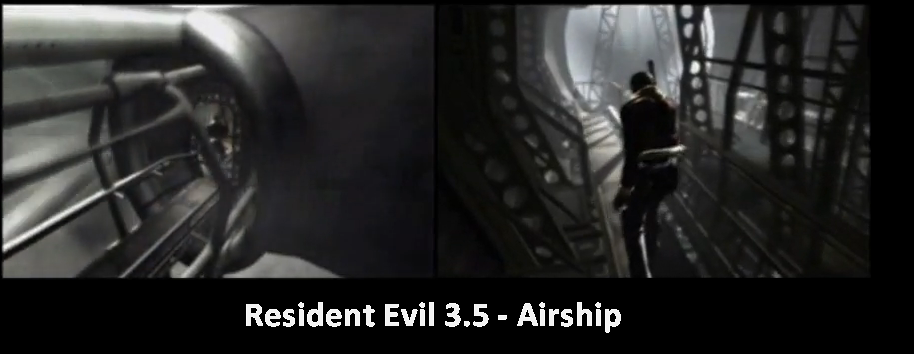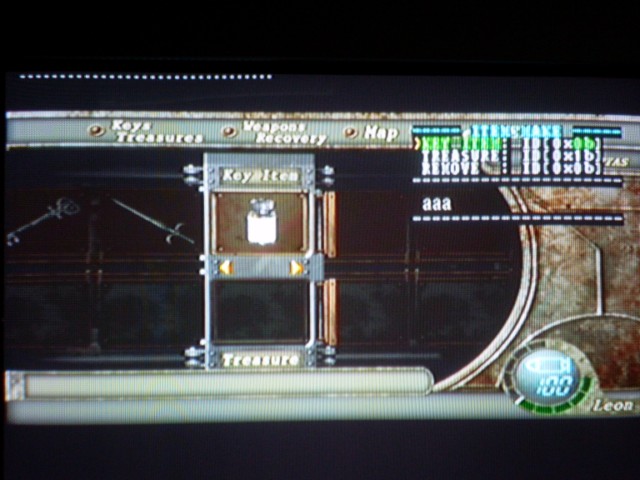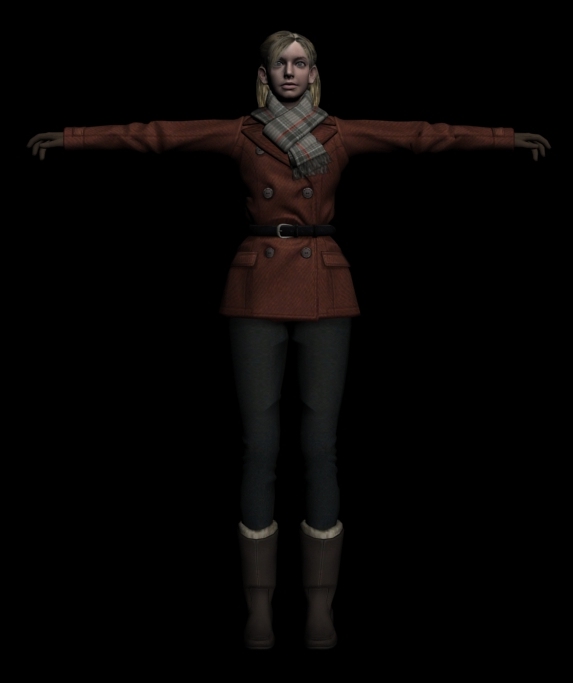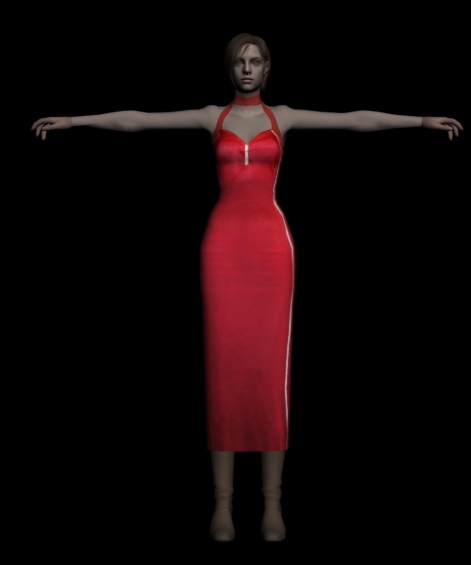Silent Hill: Homecoming is the sixth installment in the Silent Hill survival horror video game series, developed by Double Helix Games (AKA Foundation 9 studio + The Collective + Shiny Entertainment). From the pre-released screenshots, we can already see some beta differences between the “final” version and an old “beta” version, like different hair color for the protagonist and a “better” graphic. If you played the final game and notice some more beta differences in the early screens and videos, please let us know! Thanks to Brad for the contribution
Fear Effect Inferno [PS2 – Cancelled]
Fear Effect 3 Inferno is the unreleased third title in the Fear Effect series of video games developed by Kronos Digital Entertainment for the original PlayStation. Inferno was originally announced as a PlayStation 2 sequel in 2001, and the first trailer was released during the 2002 E3 event. The trailer depicted some of the only known footage of the game. The game’s status changed rapidly towards the end of 2002 and was finally canceled in 2003. However, between the announcement and the cancellation, information was scarce.
Reports varied as to the status of the game between 2002 and 2003. While an early report by GameSpot in May of 2003 described the game as simply “on hold“, IGN broke the news during their “Missing in Action” series of articles that the game had been canceled. According to IGN’s report, the game “was the first of EIDOS’ victims to its more stringent quality assurance program.”
Due to the game’s poor progress, it was either given more development time or canceled. Unfortunately, only the development staff knew of the game’s status following this condemnation. According to IGN, “at some point in late 2002 or early 2003, Kronos did indeed shop it to various publishers. Nobody, however, bit”.
Images:
Only a few screen shots exist that hint at the gameplay style of Fear Effect Inferno. Based on these images, it was concluded that the gameplay would have been nearly identical to the previous two games. However, a new weapon system would have allowed players to map a firearm to the “X” (Cross) button and another to the “O” (Circle) button on the Dual Shock 2 controller. This would have allowed numerous weapon combinations.
In addition, updated diving moves could be executed to quickly evade enemy fire. The environment itself would have allowed players to hide from hazards, such as bullets, and function as a way to avoid detection. It was rumored that players could control certain actions during scripted in-game fight scenes, requiring the player to execute timed button combinations to fight certain opponents. Fear Effect Inferno would have introduced the separation of the “Health” and “Fear” Meters. However, it is not known how the “Fear” Meter would have affected gameplay since the “Health” Meter functioned as both in the previous two titles.
News of the cancellation did not come to fans until 2004, years after the game’s initial announcement and quiet absence. Even Sandy Abe, Chief Operating Officer of Kronos, hinted that EIDOS might give the series a second chance under a new developer, such as Crystal Dynamics, but this was only true for the Tomb Raider franchise. According to an e-mail by Sandy Abe, “Unfortunately Fear Effect probably will not get picked up.“
Many fans continued to go to Kronos’, GameSpot’s, and related message boards to keep the memory alive until interest in a resurrection finally waned in late 2005. The announcement of the movie, has given hope to a new game from an existing EIDOS subsidiary. This potential title would be a video game-adaptation of the movie’s plot. Rumors of a “true sequel” involving any of the original development staff members have been dissolved.
Opinions of the thought of a sequel from one of EIDOS’ remaining studios have been mixed. Devoted fans of the first two PlayStation titles predict that, if a new game is developed, it will not follow Kronos’ storyline for Fear Effect Inferno. Early reports suggest that, if a game is released, it will follow the movie plot, which has already promised to have little relation plot-wise to the situations introduced by the video games. Therefore, only the first two games, which were developed by Kronos, are considered “canon” among fans. [Info from Wikipedia]
Thanks a lot to Takashi Morishima and to Wei Wiharjo for the help in preserving more video and screens from this lost project!
Videos:
Resident Evil 4 [Beta / Debug / Unused Stuff – GameCube & PS2]
![]()
Resident evil 4 is probably the console game with the most tormented development cycle of all time. Originally scheduled for Playstation 2 in 2001, the Capcom game had to wait four years and as many betas to take the final form. The first version, as it is well known, became Devil May Cry because the build was deemed too action-oriented to be part of the series. Nevertheless, the trappings of the Resident Evil saga were plentiful, from the fixed camera to the haunting environments.
Gamers were shocked by the announcement that Resident Evil 4 would be exclusively on the Gamecube. The first Gamecube beta was presented at TGS 2002, showing Leon in a strange metallic structure (later confirmed to be an Airship) fighting a bizarre fog creature. The few words spoken in the trailer were about the Cradle of the Progenitor Virus, and apparently the story centered on the assault of our heroes to Umbrella Europe. Moreover, Leon was probably infected and wielded odd supernatural powers.
The following year (2003) Resident Evil 4 was shown again. This version had different features and a new emphasis on the supernatural that seemed to bring the game closer to Silent Hill. In this new trailer, Leon (who still had some strange power) was inside a mansion infested with some strange presence, notably a strong creature with a hook. An extended video of this beta is featured on Biohazard 4 Secret DVD, where we can also see the Killers Armors still present in the final game on Ashley’s stage.
Although this last beta seemed to be the most promising and polished version yet, Capcom decided to start over again. The third beta, which according to the programmers featured zombies, was not even presented to the public. Finally, the Resident Evil 4 we are most familiar with was shown at E3 2004. The Resident Evil 4 Unseen Saga didn’t end there, though. After about a year of the Gamecube release, Resident Evil 4 was ported to the Playstation 2 with a few new locations.
Moreover, the trial version of the Gamecube version was hacked, revealing the names of many rooms of the various betas and really cool items like the Optical Camo and the Infrared Goggles. It seems that the programmers were still making changes to the game until the very end of development. Knowing Capcom, maybe even the setting of the last chapter of Umbrella Chronicles is lifted from the scrapped zombie version of Resident Evil 4.
Thanks to Robert Seddon for the contribution and to Jay for the english corrections!
In Formeragent‘s Youtube channel we can see an interesting video with beta comparisons.
In November 2009, Tyrant of resident-evil-beta.de discovered a pre-release version of Resident Evil 4. These are the main differences from the final game:
- You can use the silencer on the hand gun and on the tmp
- The merchant menu is very different
- You can contact Hunningham, but there is no pic of her
- You can play only the first three levels
- The screen “end of level xx” is different
- Some voices from the enemies are different
- Saddler’s voice is different
- All documents are missing
- If you pick up an item,the sound is different
- the debug menu is fully unlocked
A pic of a woman found extracting the files inside the beta. Probably just a placeholder.
Unused item
Also, Enrico Marini of the THIA forum found the beta polygonal model of Ashley and an interesting placeholder, Jill dressed with the Ada dress, in the retail version of Resident Evil 4 :
More info from DCodes7:
Resident evil 4 went through a long development cycle. Multiple prototypes were created; officially only two of those prototypes were shown to public. Resident evil 4’s development started in 1998 which involved taking a trip to Spain to study castle architecture. In December 1999 it was hinted that RE4 was in development, however the game wasn’t officially announced until 2001.
When resident evil 4 was shown to the public for the first time it was announced that the game was being developed by Capcom’s Studio 4 for the Nintendo GameCube as part of five game line up that was exclusively developed for the GameCube.
Build 1 – Fog Version
The first build that was shown to the public, nicknamed the fog version, shows Leon S. Kennedy infiltrating umbrella Europe while being chased by a fog creature. This build was shown at TGS (Tokyo Game Show) 2002. The trailer for this build hinted that Leon could have been possessed and infected by the progenitor virus. The story involved the origins of the progenitor virus – hence what is said in the trailer: “the cradle of the progenitor virus.”

EGM (Electronic Gaming monthly) interviewed director Hideki Kamiya; this interview revealed that there was a super natural ability locked inside Leon’s Left arm and a notion to an unrevealed female character! You can read the entire interview to the left of this paragraph.
In the end, after the first showing of this build, it was scrapped; because “it was too much of a departure from the resident evil series.” Eventually this build of the game evolved into what is known today as Devil May Cry.

In early 2006 it was discovered – in the debug menu on an early trial demo of resident evil 4 – that the large metal structure that is shown in the fog trailer was an airship. Only the names of the levels remained. To see all of the 3.5’s level names (Fog & Hook Man versions) click on the links below.
http://www.the-horror.com/index.php?id=features&s=re4demos&p=10
http://www.the-horror.com/index.php?id=features&s=re4demos&p=11
http://www.the-horror.com/index.php?id=features&s=re4demos&p=12
Build 2 – Hook Man
Later in 2002 resident evil 4 was revealed to the public once again at E3 2002, showing a completely different game from earlier that year at TGS. This build of the game Showcases Leon S. Kennedy in a mansion while being attacked by possessed suits of armor, possessed dolls, and killer hook man ghosts; this version of the game concentrated on the super natural and puzzle solving.
The following year in 2003, cube magazine published a six page article titled “Diary of a Mad Man.” This six page article puts build 2’s story months after the Raccoon City (Resident Evil 2) and Rockford island (code veronica) incidents. You can read all six pages of the article below this paragraph.
Thanks to the 5th survivor on the THIA forum for posting these articles!
- Cube Magazine – Page 1
- Cube Magazine – Page 2
- Cube Magazine – Page 3
- Cube Magazine – Page 4
- Cube Magazine – Page 5
- Cube Magazine – Page 6
In the end the Hook man version of Resident Evil 4 was scrapped because it was “too paranormal for the resident evil plot.” This build of Resident Evil 4 evolved into the game Haunting Ground. In 2005 a five minute game play video of build 2 was released with the biohazard 4 (Resident Evil 4) Secret DVD.
Part 1 Conclusion:
Resident Evil 4 was scrapped, evolved, only to be scrapped again. Two prototypes evolved into two games and one of those games evolved into a franchise. Resident Evil 4’s development didn’t stop there; the game continued to evolve and change as it was being developed. Though Resident Evil 4 remained roughly the same – gameplay wise – the items, collectables, enemies, and the sounds of the guns were changed until the games release. In Part 2 of the analysis I will explain and point out changes that Resident evil 4 went through based on the trials and demo’s that promoted the game.
![]() [spoiler /Clicca qui per la versione in Italiano/ /Nascondi la versione in Italiano/]Resident evil 4 è probabilmente il gioco per console con lo sviluppo più tormentato di tutti i tempi. Originariamente previsto per Playstation 2 nel 2001, il titolo Capcom ha dovuto attendere ben 4 anni e altrettante beta per assumere la forma definitiva. La prima versione è diventata come è noto Devil May Cry, poiché ritenuta troppo action per far parte della serie. Nonostante ciò, rimangono evidenti i debiti alla saga horror all’interno del gioco, dalle inquadrature alle ambientazioni.
[spoiler /Clicca qui per la versione in Italiano/ /Nascondi la versione in Italiano/]Resident evil 4 è probabilmente il gioco per console con lo sviluppo più tormentato di tutti i tempi. Originariamente previsto per Playstation 2 nel 2001, il titolo Capcom ha dovuto attendere ben 4 anni e altrettante beta per assumere la forma definitiva. La prima versione è diventata come è noto Devil May Cry, poiché ritenuta troppo action per far parte della serie. Nonostante ciò, rimangono evidenti i debiti alla saga horror all’interno del gioco, dalle inquadrature alle ambientazioni.
Poi è la volta dell’annuncio shock di Resident evil 4 esclusiva gamecube, con la presentazione della nuova versione al TGS 2002, che vede Leon all’interno di una strana struttura alla prese con un bizzarro essere incorporeo. Le poche parole presenti all’interno del trailer parlano della culla del progenitor virus, e a quanto sembra la storia era incentrata nell’assalto dei nostri eroi ad umbrella europe.
L’anno successivo (2003) il titolo viene presentato nuovamente, ma stavolta evidenziando caratteristiche differenti, che sembravano avvicinare la saga a Silent hill, con una nuova enfasi sul soprannaturale e sull’horror psicologico. Di questa versione, di cui il trailer originale mostrava solamente Leon all’interno di una magione infestata da strane presenze, in particolare da un mostro dotato di uncino, esiste anche un filmato esteso all’interno del biohazard secret dvd.
Benché si trattava sicuramente la più curata e promettente delle beta, Capcom decide nuovamente di cambiare direzione nello sviluppo, ma il nuovo titolo, che a sentire i programmatori aveva di nuovo gli zombie, non viene neanche mostrato al pubblico. Finalmente, all’e3 del 2004 viene esibita la versione definitiva, o almeno cosi si credeva. Dopo circa un anno infatti Resident Evil 4 viene convertito per Playstation 2 con delle aree aggiuntive rispetto alle release gamecube. E sicuramente ancora diverso materiale del Resident Evil 4 Project è rimasto sconosciuto al pubblico. Lo vedremo in Resident evil Wii?[/spoiler]
Images:
Videos:
Eternal Darkness [GC – Beta]
![]()
This game developed by Silicon Knights was released in June 2002, only after a long and troubled development. Full of unseen like few other games, Eternal Darkness was first announced for the Nintendo 64 at E3 1999, then moved to the GameCube. The project was changed many times during its development: in addition to the transition from one console to another, at least a couple of chapters were removed and the story was distilled when Silicon Knights realized that it would not be possible to finish the game before the release date.
At that time, the developers announced that Eternal Darkness would have been a trilogy, so that it could have been possible to explore the complete story, mitigating the impact of cuts to the game’s plot. The game’s subtitle, “Sanity’s Requiem”, was added for this exact reason, to distinguish it from the (unreleased) sequels.
Karim was not in the early builds of the game. Silicon Knights had originally placed a Templar Knight fighting against Muslims in the scenario, but later changed this in 2001. The only remnants of this character in the finished game is a cutscene before Roberto’s story showing him being taken by Pious in disguise as the “foundation” for the Pillar of Flesh, since he is able to see Pious in his true form.
Silicon Knights stated in an interview with Nintendo Power (volume 164): “At one point, the story even included one of the other, stronger characters (note: presumably Michael) taking his own life in Edward’s presence rather than face the Ancients. This scene was eventually removed because it was considered far too grim.”
The game originally included a United States Special Ops commando who falls into the pit near the pillar of flesh. Presumably this chapter was an early version of the Michael one, whose finalized intro scenes and character model show him as a Canadian firefighter who was fighting an oil well fire in Iraq. His original equipment, such as the rifle and uniform, was placed a small ways off in the same chamber, on the body of a Marine. [Info from Wikipedia]
In a couple of screens from a cinematic removed from the final game, we can see an MC-130 cargo, a real-life plane that was developed in the early 1960s and was heavily used in “Operation Desert Storm”. This plane was probably used in the early version of the Gulf War chapter in the game – likely it was the airplane that the removed Special Ops commando would have used to land.
From a series of concept art we can even notice some unused ideas for different game endings, with a zombie apocalypse after the Ulyaoth god takes over the world, a flood of people that follow Chattur’gha’s orders and a city with trees under Xel’lotath influence.
Other smaller differences in the beta version are Alexa’s shirt color (red instead of black), the removed “real time shadows” and Maximillian Roivas had still his “hairs” in the cell cutscene.
For more info, check the Eternal Darkness beta analysis!
Thanks to Jay for the english corrections!
![]() [spoiler /Clicca qui per la versione in Italiano/ /Nascondi la versione in Italiano/]Il gioco Silicon Knights uscì nel Giugno del 2002 dopo uno sviluppo che definire travagliato sarebbe un eufemismo. Ricco di unseen come pochi altri, questo titolo venne annunciato su Nintendo 64 all’E3 del 1999, per poi essere spostato su GameCube. Il risultato fu buono, tanti lo odiano, altrettanti lo amano, certo è che il gioco venne modificato tante volte durante lo sviluppo: oltre al passaggio da una console all’altra vennero eliminati interi capitoli, la storia venne distillata, tutto faceva presagire che sarebbero arrivati dei seguiti a completare l’idea del progetto originario. Finora comunque non se ne sa nulla (escluse le vacue speculazioni), il tutto a favore degli appassionati degli beta.
[spoiler /Clicca qui per la versione in Italiano/ /Nascondi la versione in Italiano/]Il gioco Silicon Knights uscì nel Giugno del 2002 dopo uno sviluppo che definire travagliato sarebbe un eufemismo. Ricco di unseen come pochi altri, questo titolo venne annunciato su Nintendo 64 all’E3 del 1999, per poi essere spostato su GameCube. Il risultato fu buono, tanti lo odiano, altrettanti lo amano, certo è che il gioco venne modificato tante volte durante lo sviluppo: oltre al passaggio da una console all’altra vennero eliminati interi capitoli, la storia venne distillata, tutto faceva presagire che sarebbero arrivati dei seguiti a completare l’idea del progetto originario. Finora comunque non se ne sa nulla (escluse le vacue speculazioni), il tutto a favore degli appassionati degli beta.
Per maggiori informazioni: Seghe mentali su Eternal Darkness Beta [/spoiler]
Images:
Videos:
Clock Tower 3 [PS2 – Beta]
ENG: This entry in the archive doesn’t have a description yet. If you want to add some info about the beta / cancelled stuff that you see in these images, just write a comment or send us an email! We’ll add your info in this page and your name in the contributors list. Thanks a lot for your help! :)
ITA: Questa pagina dell’archivio non ha ancora una descrizione. Se vuoi aggiungere delle informazioni riguardo le differenze della beta o la descrizione di un gioco cancellato, lasciaci un commento o mandaci una email! Inseriremo le tue informazioni nella pagina ed il tuo nome nella lista dei collaboratori. Grazie per il tuo aiuto! :)
Images:
source: Capcom Central
Video




